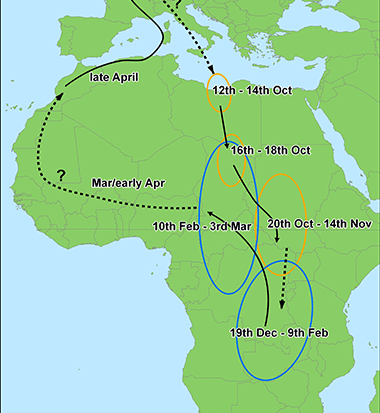Migration Marvels Part 1
Always to be where living conditions are best: this is the luxury that only those with wings can afford! With the end of the season fast approaching for the ground-nesting birds, as well as us seasonal wardens, thoughts now turn to the marvels of migration. Many of the birds found on our heathlands will migrate to warmer climes at some point over the next month or two. Some will make epic journeys to the southern hemisphere, others may only go as far as southern Europe and a few will stay put to make the best of the UK’s mild winters.
Only in the last 100 years have we really begun to understand migration. In the past people had weird and wonderful stories to explain the absence of our migratory birds. Hibernating in trees or at the bottom of lakes, travelling to the moon or even transmogrification – the idea that birds magically turned into other species, such as Redstarts turning into Robins. Just some of the prevailing thoughts! As crazy as this may seem to us, scientists at the time lacked our modern technology or even an accurate map of the world. And, let’s be honest, the truth – tiny birds weighing only a few grams travelling thousands of kilometres year after year – is actually just as mind boggling! With the advent of GPS and satellite tracking technology we are continuing to discover incredibly detailed information on the routes, destinations and timings of bird migration.
Nightjars are the stars of our heaths and will have travelled close to 10,000 miles by the time they get back to us next May. They are true long distance migrants. We have known for a while that Nightjars show high site fidelity i.e. returning to the same site year after year, but very little was known about where they wintered. A project in 2011, which saw several birds fitted with GPS trackers, revealed that the main wintering site is in the southern part of the Congo. Somewhere that wasn’t previously identified as a wintering area for this species, although our Cuckoos also spend their winters there. The map shows the migration route of one particular bird that was tracked from Norfolk. It seems this particular bird actually took his time travelling through Europe. Nightjars usually start leaving around August, arriving in Libya in October, not reaching the overwintering ground in the Congo until mid-December. It also shows that it took a completely different and less direct way back, travelling through the North West of Africa before reaching Europe in early May. The reason behind this is unknown!

Nightjar migration route recorded by the British Trust for Ornithology (https://www.bto.org/about-birds/species-focus/nightjar)
Warden Conor
